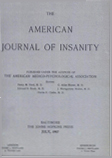Abstract
An analysis is presented of a thousand cases of patients admitted to the City of Detroit Receiving Hospital because of attempted suicide. It is pointed out that such a group is somewhat selected, and is not entirely representative of the whole class of patients who attempt suicide, especially because of the absence of patients who used rapidly fatal means, and because of the relative infrequency with which the wealthier patients are brought to the hospital.
This group confirmed the usual finding of a higher rate of attempts at suicide among females, with a greater number of successes among males. The curve of distribution by age contained, among females, a conspicuous peak between the ages of 20 and 24 years, and very few cases after the age of menopause. Among males, the peak of the curve came between the ages of 25 and 29 years, and there was very little decline in the rate of suicide with advancing years. Members of the negro race made a relatively larger number of attempts at suicide and achieved relatively smaller number of successes than members of the white race. The marital distribution of the group studied displayed nothing significant except in the large number of divorced women. The data disclosed a relatively much greater incidence of attempted suicide among Protestants than Catholics. It is pointed out, however, that a comparison of the religious preferences of these patients with the religious census of Detroit is likely to be very unreliable.
The percentage of unemployed among the gainful workers of this series was significantly greater than in the general population. Attempts at suicide were relatively rare in the early morning, and most frequent in the evening. They were also relatively rare in the middle of the week, and most frequent near the week-end, especially on Sunday and Monday. Serologic tests were completed on nearly half of the patients, and surprisingly, a much higher proportion of positive results was secured among female patients. The leading motives assigned for the attempt by male patients were 500 A THOUSAND CASES OF ATTEMPTED SUICIDE [Nov. economic difficulties, and by female patients, marital, domestic, or amatory discord. Twenty-three per cent of the patients received some psychiatric diagnosis, which in a little more than half of the cases was of some phase of acute or chronic alcoholism. Poisoning was the leading means employed by both sexes, although the relatively greater preferences of males for mechanical methods largely accounted for the greater proportion of deaths among male patients. The almost wholly innocuous tincture of iodine was the most popular poison. It was followed in order of frequency, by the much more dangerous solution of cresol (lysol), mercuric chloride, and phenol, in order of frequency.
Only a small number of the patients were committed to institutions for prolonged custodial care. Most of them were released either to their relatives or on their own responsibility. On the basis of the present data, the prediction is made that only a small percentage of these patients will make another attempt at suicide.

